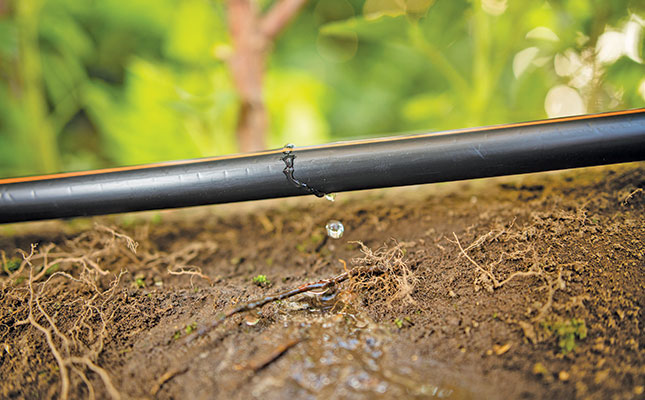| 500Foods shared this story from |

The prime purpose of precision irrigation is to deliver the correct quantity of nutrients and water to the plant at the optimal time and in the right place.
To achieve this, the system continuously monitors climate, soil, leaf moisture and other variables, and adjusts irrigation according to these needs.
“When you develop a new farming project or, for example, a new orchard or vineyard, a host of questions must be answered, and a team of irrigation experts must be involved in the process,” says Chris Malan, agronomy manager at Netafim South Africa.
“Irrigation planning is based on data from analyses done and decisions made throughout the planning process.”
Variables to consider
As a farmer, your first task is to analyse a number of basic, but crucial, agronomic variables:
- The climate in your area;
- The soil type (physical and chemical attributes);
- Water composition and availability;
- Topography (the shape and features of the terrain);
- The availability of electricity;
- Diseases and pests.
Based on these variables, you can then decide on the following:
- Suitable crops and/or cultivars;
- The optimal way to prepare the soil;
- Fertiliser requirements;
- The direction of the rows, and the size and design of the planting blocks;
- The plant spacing, row lengths, and similar aspects.
Once you have established these details, you can decide on the particular irrigation method, its design and the irrigation schedule.
With new developments in centralised control, block sizes are becoming the basis of water and nutrition management.
“A properly designed and planned irrigation system that’s managed correctly will accommodate all of these variables and will therefore ensure total control of water and nutrition levels,” says Malan.
“There is no single, perfect irrigation system. You have to consider all of the advantages and disadvantages of a system and make a decision based on the particular circumstances of your farm, bearing all these variables in mind.”
After deciding on the agronomic variables, you will need to consider a range of more general issues before choosing the system that’s best for you:
- The capital and running costs of the system;
- Your personal knowledge of the system;
- The management and maintenance ease of the system and your farmworkers’ ability to operate it properly;
- The reliability of the system;
- The farm’s capacity to manage the nutrition levels and scheduling optimally;
- The occurrence of wind, weeds and other potential problems;
- The installation requirements, especially in terms of labour and equipment;
- The possibility of theft.
Note that precision irrigation can be carried out successfully with both drip irrigation and micro-sprinkler systems.
Micro-irrigation systems
Irrigation with micro sprinklers allows for full-surface and localised irrigation. As with any system, it has both advantages and disadvantages.
Advantages
– Micro-sprinkler irrigation wets a larger volume of soil than drip irrigation does, which makes irrigation management easier;
– Emitter blockages are more visible.
Disadvantages
– Micro sprinklers are 85% efficient in applying water, 10% lower than drip irrigation systems;
– Evaporation losses are higher during water application and from the soil surface;
– Labourers cannot work on the land during active irrigation;
– Maintenance costs are higher due to occasional damage caused by working on the land;
– Some fertiliser tends to be wasted due to less efficient application;
– Some water falls onto the leaves rather than being delivered to the root zone.
Drip-irrigation systems
These systems in turn offer a number of advantages and disadvantages relative to micro-sprinkler irrigation.
Advantages
– Water-use efficiency is far higher; drip irrigation is 95% efficient in applying water, and water is delivered directly to the root zone;
– Drip irrigation makes it possible to apply fertiliser via the irrigation system (fertigation), a highly efficient form of fertilisation;
– The system results in limited evaporation during water delivery and from the soil surface, improved weed management and efficient pulse irrigation;
– Drip irrigation uses no moving parts, which means less maintenance;
– Labourers can work in the orchard during active irrigation.
Disadvantages
– The emitters in a drip irrigation system tend to clog more readily than those in a micro-sprinkler system;
– Blockages are not always visible;
– Finer, and hence more expensive, filtration is needed;
– In poor soil, the distribution of water may not be as desired;
– The system has to be very well managed.
Which emitters are best?
Once you have chosen between a drip and a micro-sprinkler irrigation system, you will need to decide on the configuration of the system.
In the case of micro-sprinkler irrigation, the two most important decisions are sprinkler selection and irrigation scheduling.
Malan explains that a manageable soil volume (between 40% and 60%) that does not have to be refilled daily must only be wetted; more frequent refilling leads to higher evaporation losses. The infiltration rate of the soil must not be exceeded.
Your choice of micro-sprinkler will be determined by crop requirements, planting density, irrigation goals, soil type and soil preparation choices.
When it comes to drip irrigation, the key considerations are crop water requirements, the required wetted area, application rate, working hours, the type of dripper and dripper delivery rate, dripper spacing and irrigation scheduling.
The choice of dripper will be determined by topography (you may, for example, need a pressure-compensated dripper if the land is sloped), the number of growing seasons and water quality.
To decide on the correct dripper spacing, you need to appreciate the following concepts:
- Water moves differently in different soil types;
- Every soil has its own width and depth distribution;
- A longer irrigation time means wider and deeper water distribution.
To collect this information requires performing certain measurements and calculations.
“The final goal is to develop a scheduling plan that’s user- friendly, ensures sustainable production, and delivers uniform results,” says Malan.
One of the important tests that must be done during planning is the simple soil water distribution test; this determines the width-to-depth wetting ratio of the soil.
“Other data provides information on how deep to irrigate. After this test, we’ll also know how wide the distribution of the water will be. This information, combined with knowing the soil’s water-holding capacity, tells us the size of the soil reservoir,” says Malan.
To perform the soil water distribution test, place a bucket of 5ℓ to 10ℓ capacity on a platform 40cm above the soil surface and fill it with water. Connect a dripper with a similar flow rate to the drippers used in the system, to a thin pipe. Place the pipe at the bottom of the bucket and let the water flow onto the soil. You can then open a profile pit and check the water distribution pattern.
Visit netafim.co.za, or email infoza@netafim.com.

